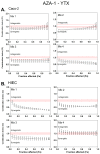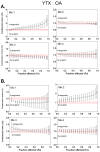Combined Effects of Lipophilic Phycotoxins (Okadaic Acid, Azapsiracid-1 and Yessotoxin) on Human Intestinal Cells Models
- PMID: 26907345
- PMCID: PMC4773803
- DOI: 10.3390/toxins8020050
Combined Effects of Lipophilic Phycotoxins (Okadaic Acid, Azapsiracid-1 and Yessotoxin) on Human Intestinal Cells Models
Abstract
Phycotoxins are monitored in seafood because they can cause food poisonings in humans. Phycotoxins do not only occur singly but also as mixtures in shellfish. The aim of this study was to evaluate the in vitro toxic interactions of binary combinations of three lipophilic phycotoxins commonly found in Europe (okadaic acid (OA), yessotoxin (YTX) and azaspiracid-1 (AZA-1)) using the neutral red uptake assay on two human intestinal cell models, Caco-2 and the human intestinal epithelial crypt-like cells (HIEC). Based on the cytotoxicity of individual toxins, we studied the interactions between toxins in binary mixtures using the combination index-isobologram equation, a method widely used in pharmacology to study drug interactions. This method quantitatively classifies interactions between toxins in mixtures as synergistic, additive or antagonistic. AZA-1/OA, and YTX/OA mixtures showed increasing antagonism with increasing toxin concentrations. In contrast, the AZA-1/YTX mixture showed increasing synergism with increasing concentrations, especially for mixtures with high YTX concentrations. These results highlight the hazard potency of AZA-1/YTX mixtures with regard to seafood intoxication.
Keywords: cytotoxicity; enterocytes; lipophilic phycotoxins; mixtures.
Figures



Similar articles
-
Mixtures of Lipophilic Phycotoxins: Exposure Data and Toxicological Assessment.Mar Drugs. 2018 Jan 31;16(2):46. doi: 10.3390/md16020046. Mar Drugs. 2018. PMID: 29385038 Free PMC article. Review.
-
Combined effects of okadaic acid and pectenotoxin-2, 13-desmethylspirolide C or yessotoxin in human intestinal Caco-2 cells.Chemosphere. 2019 Aug;228:139-148. doi: 10.1016/j.chemosphere.2019.04.018. Epub 2019 Apr 5. Chemosphere. 2019. PMID: 31029959
-
First report on azaspiracid and yessotoxin groups detection in French shellfish.Toxicon. 2008 Jul;52(1):39-48. doi: 10.1016/j.toxicon.2008.05.006. Epub 2008 May 29. Toxicon. 2008. PMID: 18573273
-
Modulation of CYP3A4 activity alters the cytotoxicity of lipophilic phycotoxins in human hepatic HepaRG cells.Toxicol In Vitro. 2016 Jun;33:136-46. doi: 10.1016/j.tiv.2016.02.021. Epub 2016 Mar 5. Toxicol In Vitro. 2016. PMID: 26956883
-
Cytotoxicity and intestinal permeability of phycotoxins assessed by the human Caco-2 cell model.Ecotoxicol Environ Saf. 2023 Jan 1;249:114447. doi: 10.1016/j.ecoenv.2022.114447. Epub 2022 Dec 23. Ecotoxicol Environ Saf. 2023. PMID: 38321666 Review.
Cited by
-
Lipophilic Toxins in Wild Bivalves from the Southern Gulf of California, Mexico.Mar Drugs. 2021 Feb 9;19(2):99. doi: 10.3390/md19020099. Mar Drugs. 2021. PMID: 33572171 Free PMC article.
-
The Combination of Gold and Silver Food Nanoparticles with Gluten Peptides Alters the Autophagic Pathway in Intestinal Crypt-like Cells.Int J Mol Sci. 2023 Aug 22;24(17):13040. doi: 10.3390/ijms241713040. Int J Mol Sci. 2023. PMID: 37685847 Free PMC article.
-
Current Research Status of Azaspiracids.Mar Drugs. 2024 Feb 4;22(2):79. doi: 10.3390/md22020079. Mar Drugs. 2024. PMID: 38393050 Free PMC article. Review.
-
Mixtures of Lipophilic Phycotoxins: Exposure Data and Toxicological Assessment.Mar Drugs. 2018 Jan 31;16(2):46. doi: 10.3390/md16020046. Mar Drugs. 2018. PMID: 29385038 Free PMC article. Review.
-
Effects of okadaic acid, azaspiracid-1, yessotoxin and their binary mixtures on human intestinal Caco-2 cells.EXCLI J. 2024 Apr 22;23:509-522. doi: 10.17179/excli2023-6884. eCollection 2024. EXCLI J. 2024. PMID: 38741723 Free PMC article.
References
-
- Rossini G.P., Hess P. Phycotoxins: Chemistry, mechanisms of action and shellfish poisoning. In: Luch A., editor. Molecular, Clinical and Environmental Toxicology. Birkhäuser; Basel, Switzerland: 2010. pp. 65–122. - PubMed
-
- Marine Biotoxins in Shellfish—Summary on Regulated Marine Biotoxins. [(accessed on 19 February 2016)]. Available online: http://www.elika.net/datos/articulos/archivo_en448/marinebiotoxins_en.pdf.
-
- Dominguez H.J., Paz B., Daranas A.H., Norte M., Franco J.M., Fernández J.J. Dinoflagellate polyether within the yessotoxin, pectenotoxin and okadaic acid toxin groups: Characterization, analysis and human health implications. Toxicon. 2010;56:191–217. doi: 10.1016/j.toxicon.2009.11.005. - DOI - PubMed
-
- Yasumoto T., Murata M., Oshima Y., Sano M., Matsumoto G.K., Clardy J. Diarrhetic shellfish toxins. Tetrahedron. 1985;41:1019–1025. doi: 10.1016/S0040-4020(01)96469-5. - DOI
MeSH terms
Substances
LinkOut - more resources
Full Text Sources
Other Literature Sources

